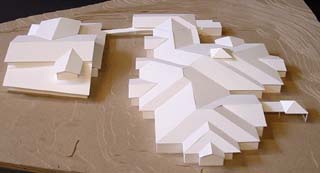|
Subscribe / Renew |
|
|
Contact Us |
|
| ► Subscribe to our Free Weekly Newsletter | |
| home | Welcome, sign in or click here to subscribe. | login |
Construction
| |
 |
August 12, 2004
Architects are from Mars, educators are from Venus
Architects BCRA

Katica
|
No longer are owners and stakeholders inclined simply to follow the advice to "trust us." Architectural firms must now support their claims of omniscience with the aid of experts in education and communication: educational specialists.
Research proves that schools can be designed, engineered and provisioned to assist learning. Though a school's curriculum and educational goals play an important role in shaping its needs, schools don't always convey these attributes and aspirations to designers effectively. And designers, for their part, don't always know how to incorporate educational needs into their final designs.
Role of the specialist

School designers build massing models, like this one for Seattle’s Maple Elementary, at the conclusion of the pre-design process to give form to programmatic ideas. Educational specialists help ensure such models accurately incorporate the needs of the schools and their communities.
|
Educational specialists who have experience as teachers or administrators and an understanding of architecture can translate for both sides. Such specialists facilitate communication and coordination. Specialists must also be aware of other issues that affect the design process, including socioeconomic influences, evolving teaching methods, and state and federal educational requirements.
"The educational specialist brings the educator's perspective to meetings," says Don Gilmore, project manager for Seattle Public Schools' Building Excellence II capital projects program.
Gilmore notes that while architects and engineers tend to think along linear or visual lines, teachers may take an abstract or verbal approach. A liaison who can join the two thought processes is a valuable asset to have on the team, he says.
Some architects may become complacent in education projects. They may feel they already know the drill because they have already successfully designed and built schools. However, there are school district administrators, educators and other stakeholders who are involved with only one or two projects in their careers.
On the surface, this could lead educators to believe that the architect understands the needs of a school and incorporate those needs into the project. However, an architect may not have the practical experience of a teacher or understand the demands of a school administrator and the challenges of providing a quality education.
Educational specialists can help stakeholders express these emotions and needs to the building designer. They can unmask hidden agendas that push planning and design efforts off track, and encourage other key stakeholders who may be too cautious to speak up to formulate their ideas and concerns. Specialists keep both sides aligned throughout the pre-design phase.
In many cases, educational specialists draw upon their teaching experience and develop lesson plans for early design meetings to identify project priorities such as storage requirements, acoustical levels or teaching methods, keeping these the primary focus of discussions.
Linking owners, architects
Much as finger joints interlock two shorter pieces of wood end-to-end to create a stronger connection, educational specialists assist both the owner and the architect by strengthening the link of understanding and communication. When educational specialists recognize any disconnect between key stakeholders or designers, a calm, patient approach is best.
At BCRA, we have seen the successful integration of specialists into many phases of the design process.
For example, some owners have in-house owner representatives and construction administrators who work as a liaison between the owner, design team and contractor to ensure understanding and continuity of the project's design from one phase to the next. Educational specialists become involved at the early phase of a project, when the program is being developed and the conceptual design is being articulated into graphic form.
Specialist at work
Jan Brown has been the educational specialist at BCRA since 2002, and has been involved with projects in the Seattle and Tacoma area.
As a specialist, Brown has often drawn from her experience as a teacher and principal in developing community groups and coordinating bond-passage materials for proposed school projects. Her work allows the architects to focus more on the physical aspects of the design process.
Relationships important
In school design, relationships are the most important contributor to successful design. Communication builds those relationships.
"All of us together on our worst day are better than just one of us on our best," says Pat Hunter, principal of Maple Elementary School in Seattle.
Educational specialists should have the ability to bring out the best qualities from administrators, faculty and community members.
If the design team can fully understand the needs of the school and other stakeholders, the design process has a better chance of incorporating the school's educational needs and practices.
Inviting an educational specialist into the design process can enhance communication and understanding, and result in a school that promotes effective learning.
Bob Katica is an associate principal at Architects BCRA.
Other Stories:
- Fast-track school projects require careful planning
- A little cooperation goes a long way
- Misunderstood fungus exacts a costly toll
- Restoring order to the school-design process
- Stucco makes a comeback
- A second wind for historic schools
- New vocational center a model for innovation
- Alternative school-funding models pay off
- Achieve good design within budget
- Research fuels UW space needs
- Schools to experiment with sustainability


